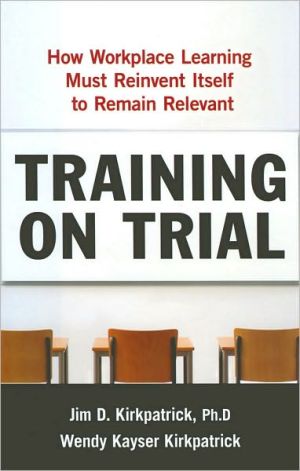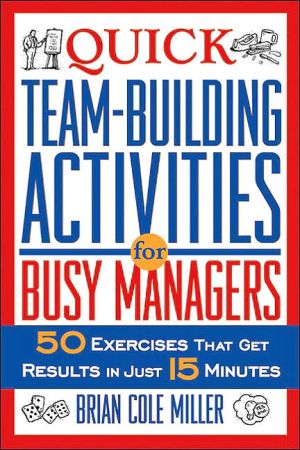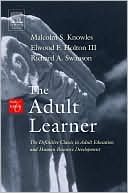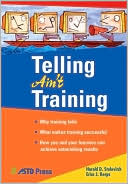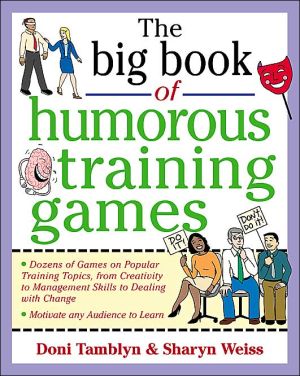Training on Trial: How Workplace Learning Must Reinvent Itself to Remain Relevant
Praise from Training Professionals for Training on Trial:\ “Training on Trial should be a required read for anyone in the business of buying, building, and delivering training.” — Judith Hale, Ph.D., CPT, Hale Associates\ “This book is simply the most important read, now, for anyone engaged in the management and leadership of learning & development activity.” — Craig Hiles, Managing Partner, Whitestone, Inc., UK\ “Training on Trial both forewarns us of the dangers of becoming complacent...
Search in google:
Praise from Training Professionals for Training on Trial:“Training on Trial should be a required read for anyone in the business of buying, building, and delivering training.” — Judith Hale, Ph.D., CPT, Hale Associates“This book is simply the most important read, now, for anyone engaged in the management and leadership of learning & development activity.” — Craig Hiles, Managing Partner, Whitestone, Inc., UK“Training on Trial both forewarns us of the dangers of becoming complacent training providers and directs us to be proactive…A must-read for all training practitioners in the 21st century.” — David Cory M.A., President, The Emotional Intelligence Training Company, Inc.“Perhaps, the next time you step into an elevator, you could be greeted by your senior executive with, ‘How’s it going with training?’ In Training on Trial, Jim and Wendy Kirkpatrick help the CLO and staff lay out their ‘opening remarks’ with confidence and foresight. From whatever sector—private, government, or nonprofit—the examples and clear thinking about the Kirkpatrick levels of training evaluation will serve as preparation for your response to the potential plaintiff’s complaint, ‘What has training done to help us?’” — Harold Welch, Ph.D., SPHR System Manager, Leadership and Knowledge Management, U.S. Office of Personnel Management“Training on Trial contains tips, tools, quizzes, examples, and case studies that help you build a ‘chain of evidence.’ Written in an engaging and practical style, Jim and Wendy introduce a new vocabulary that I hope will become common in the L&D world. They have changed the way I think and talk about training with my ‘jury.’” — Glenn Hughes, Director of Global Learning, KLA Tencor, Inc.“In Training on Trial, Jim and Wendy Kirkpatrick provide learning professionals a practical and realistic guide to remaining relevant to the bottom line…A must-read for anyone in the learning and development arena. — Kimberly Middleton, Supervisor, Learning and Development, Navy Federal Credit Union“Yes, Training is on Trial, but the verdict is in favor of Jim and Wendy’s latest book.” — Elaine Biech, author of The Business of Consulting and Training for Dummies
1\ The Case Against Us\ ‘‘We are confronted with insurmountable opportunities.’’\ —Pogo\ ON THE MORNING OF November 14, 2003, I was summoned to the office of the new CEO, RobertWarrington, of First Indiana Bank, where I was serving as the Director of Learning and Development. Since he took over earlier that year, Robert and I had had several informal conversations about training, the Indianapolis Colts, local restaurants, and world travels. Our interactions were cordial, friendly, and productive. My job had been an enjoyable and worldwide experience for eight years.\ I made sure I was all decked out that morning—even wore a suit and tie. I was not sure what was on Robert’s agenda, other than it was ‘‘training related.’’ I arrived at my office early enough to brush up on the latest initiatives my L&D team of six members was in the midst of, and I thought up a few new ones case Robert was interested in expanding our influence to the thousand or so bank employees.\ I rode the elevator up to the twenty-eighth floor, where I was summoned into Robert’s office right on time. As I walked\ through the door, something happened that had never occurred during my prior visits. I heard a ‘‘click’’ as the large wooden door shut behind me. I began to wonder what type of meeting this w s going to be, as I walked the twenty or so steps to Robert’s expansive, polished mahogany desk, where he sat with arather somber look on his face. My next thoughts came quickly, one on top of the other. ‘‘Uh, oh . . . something is wrong—trouble of some kind, just like being called to the principal’s office. He is going to give me bad news.’’\ After exchanging some nervous pleasantries, he got right to ‘‘Jim, we have decided to make a change in the way we do\ training here. I have decided to eliminate the positions of the six trainers on your team. I want you to stay, however. I have\ confidence in you that you can carry on alone, and can utilize the fine business managers we have to pick up the slack.’’\ In recent years, this scene has recurred many times for many eople. It takes di ferent forms, but the message is remarkably consistent: Executives have become wary of the value that training brings to the business in relation to the investment that is made. Research by several major training-related groups clearly shows that learning professionals and training departments that emphasize the training event as key to business results are particularly vulnerable to this type of action.\ I learned a valuable lesson that day back in 2003. My department had been on trial and we didn’t even know it! And worse, the verdict from the new CEO was, for the most part, ‘‘guilty.’’ I vowed back then to no longer count on good relationships between ‘‘us trainers’’ and our business partners—or the great programs we deliver. Instead, I concentrate now on understanding what our stakeholders—our key business partners—expect from us. I focus our training, reinforcement, and coaching efforts not only on creating strategic value but also on demonstrating that value. I also vowed to help as many people as possible to prepare for the time when they may find themselves on trial.\ In 1959, ASTD published Don Kirkpatrick’s articles on the four levels. In the first article, Kirkpatrick cited Daniel\ Goodacre’s work with BF Goodrich and quoted Goodacre: ‘‘Training directors might be well advised to take the initiative and evaluate their programs before the day of reckoning arrives.’’ Many still need to heed that warning from over 50 years ago. The tradition that training value comes mostly from design, development, and delivery (Levels 1 and 2; see Table F-1) is imbedded in the world’s learning culture. This book is designed to offer—nay, shout—yet another wake-up call: Learning professionals at all levels and in all types of organizations must extend their roles beyond tradition. To help you achieve this end, we’ve provided a model and the specific steps that will help you become a genuine strategic business partner. Additionally, we’ve scattered many ‘‘business partnership tips’’ throughout the book, and these are\ applicable to professionals in any situation. Fore example, here's the first such tip.\ Business Partnership Tip: Take an honest and objective look at your job, role, and function as if you were a practicing attorney. What evidence can you provide to demonstrate your value to the bottom line of the business in relation to your efforts?
Foreword Donald L. Kirkpatrick Kirkpatrick, Donald L.1 The Case Against Us 12 Taking the Case 193 The Foundation of Our Defense 314 Step 1: Pledge to Work Together 515 Step 2: Address Important Jury Issues 696 Step 3: Refine Expectations to Define Outcomes 897 Step 4: Target Critical Behaviors and Required Drivers 1018 Step 5: Identify Necessities for Success 1239 Step 6: Execute the Initiative 14710 Step 7: ROE[superscript SM], or Return on Expectations[superscript SM] 16311 Examples from Our Stars 19712 Call to Action 221Index 227
\ From the Publisher“If you are a training manager…if you pay for training or request training, you need to read this book… then strongly suggest your training manager read it, too.”―Quality Progress\ \ \
